COVID-19 pandemic brought clean water, basic hygiene practices and sanitation to the centre stage with these becoming crucial to deal with the health crisis. Budget 2021-2022 presented by the Union Finance Minister Nirmala Sitharaman on February 1, 2021 was quite distinct from earlier ones as it had to address the ongoing fiscal crisis. Sitharaman emphasised the universal coverage of water supply as a prerequisite to achieving universal health. In her budget speech, she made some announcements in line with that but not all these were amply reflected in the budget estimates.
THE FINANCIAL PROVISIONS[i]
Approximately 77,352 crore rupees has been proposed for the water domain that spreads across the Ministry of Jal Shakti, Ministry of Agriculture and Farmers’ Welfare, Ministry of Rural Development and Ministry of Housing and Urban Affairs[ii]. This allocation is almost double of last year’s budget estimate.
Most of the credit goes to the allocation to Jal Jeevan Mission (JJM) of almost 50,000 crores for providing functional household tap connection (FHTC) in rural India. The target for the financial year 2021-22 is to achieve an additional 3 crore FHTCs.
During the 2020-2021 financial year, against the proposed 38,778 crores, the revised budget allocation had decreased to 28,848 crores, amounting to almost a 25% decrease in allocation. Budget provision to Pradhan Mantri Krishi Sinchai Yojana (PMKSY), the government’s flagship scheme is 11,588 crores, which is almost equal to the last year’s allocation.
MINISTRY OF JAL SHAKTI
Comprised of the Department of Drinking Water and Sanitation and the Department of Water Resources, River Development and Ganga Rejuvenation, the Ministry of Jal Shakti has been allotted a budget of 69,052 crores, which is 130% more than last financial year’s allocation. Almost all of the increased budget is for JJM-Rural.
In the Department of Water Resources, River Development and Ganga Rejuvenation, as usual, the key share was allotted to major and medium irrigation projects. Out of the total allocated 9,022 crores, 5,588 crores was given to the PMKSY components. This includes Har Khet Ko Pani (HKKP) - 900 crores, Flood Management and Border Areas Programme (FMBAP) - 636 crores, Atal Bhujal Yojana (ABY) - 300 crores, servicing of loans from NABARD under PMKSY - 3600 crores and special package for Vidarbha and Marathawada - 400 crores.
Like in previous years, this year too nearly 40% of the amount is going for servicing of loans from NABARD under PMKSY which includes payment of interest for NABARD. Further, the National River Conservation Plan (NRCP) has been allocated 850 crores which is almost equal to last year’s allocation. The allocation for Namami Gange programme has seen a sharp decrease of 25% as compared to last year’s 800 crores. Almost all components under the financial head of ‘Water Resources Management’ remain roughly the same as last year’s allocation.
For the Department of Drinking Water and Sanitation, there is a considerable change in the total allocation of 60,030 crores as compared to last year’s 21,518 crores. The Jal Jeevan Mission (JJM)/National Rural Drinking Water Mission is allocated a sum of 50,011 crores. This indicates the priority of the state to ensure clean and accessible water to all.
In the financial year 2020-21, a total of 2.14 crore additional FHTCs were provided and 26 districts of the country had achieved 100% FHTC. It is expected that with the relatively higher allocation to JJM, the focus of the program will move towards behavioural, institutional and water resources sustainability aspects, instead of only achieving the physical target of tap connections.
The Swachh Bharat Mission (Rural) has been allocated a sum of 9,994 crores to ensure the sustainability of Open Defecation Free (ODF) status in rural areas and to cover all the villages of the country with solid and liquid waste management arrangements.
MINISTRY OF AGRICULTURE AND FARMERS' WELFARE
Under the banner of Pradhan Mantri Krishi Sinchai Yojana (PMKSY) - Per Drop More Crop, a total allocation of 4,000 crores has been made, which is equal to last year’s budget estimate. The Micro Irrigation Fund (MIF), with a corpus of 5,000 crores had been created earlier under NABARD. The same is doubled this year by allocating another 5,000 crores.
MINISTRY OF RURAL DEVELOPMENT
In the Department of Land Resources for the Pradhan Mantri Krishi Sinchai Yojana (PMKSY) - Integrated Watershed Development Program, a total allocation of 2,000 crores has been made, which is equal to last year’s allocation. A lot of watershed and water conservation work was undertaken under MGNREGA scheme during the lockdown period. In the Department of Rural Development, this year MGNREGA fund is increased by 20% as compared to last year’s 61,500 crores.
MINISTRY OF HOUSING AND URBAN AFFAIRS
In connection with the urban water and sanitation aspects, two major development took place in this year’s budget speech.
First, Jal Jeevan Mission (Urban) will be launched to attain the universal water supply in all 4,378 Urban Local Bodies (ULBs) with 2.86 crores household tap connections. Also, there is a plan to do liquid waste management in 500 AMRUT cities. These will be implemented over 5 years, with an outlay of 2,87,000 crores. No exclusive financial provision is made under this for the current financial year. All the activities will be carried out under the AMRUT scheme.
Second, Urban Swachh Bharat Mission 2.0 will be implemented with a total financial allocation of 1,41,678 crores over 5 years from 2021-2026. The focus will be on complete faecal sludge management, wastewater treatment and source segregation of garbage. Under the scheme of Swachh Bharat Mission – Urban an allocation of 2,300 crores is made, which is equal to last year’s allocation.
OTHER ALLOCATIONS
Under the Ministry of Environment, Forests and Climate Change (MoEFCC), financial provision is made under the head of National Coastal Management Programme (200 crores), Environment Protection, Management and Sustainable Development (136 crores), Control of Pollution (470 crores), National Mission for a Green India (9290 crores) and Conservation of Natural Resources and Ecosystems (62 crores). The total outlay of MoEFCC had been reduced by almost 200 crores as compared to last year’s budget allocation of 3,100 crores.
For the Inland Water Transport, under the Ministry of Ports, Shipping and Waterways a total outlay of 624 crores has been made.
THE PARADOX
The progress and success of a program or scheme does not depend solely on the financial provision but is also related to the planning of expenditure, stage of expenditure and approach of expenditure. This year’s union budget estimates reflect three things prominently.
One, there is a significant gap between the estimated budget allocation and actual expenditure. Second, though the government has prioritised the drinking water and sanitation sector, all other livelihoods, economic and ecological aspects are substantially under-allocated. And third and most important, the approach is largely inclined towards an engineering approach rather an interdisciplinary and inclusive paradigm.
For the past three years (2018-19, 2019-20 and 2020-21), the revised estimates for the water sector is almost 25% lesser than the initial budget allocation[iii]. The same pattern is visible for various financial heads under different ministries.
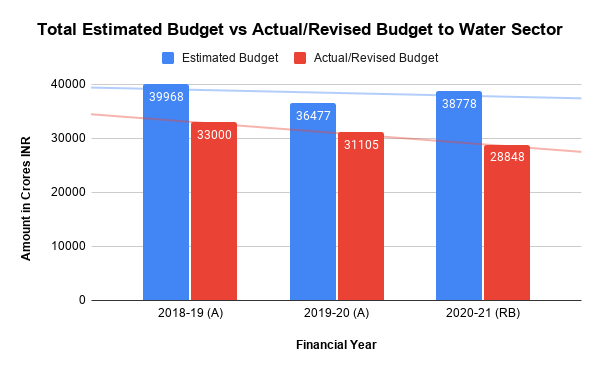

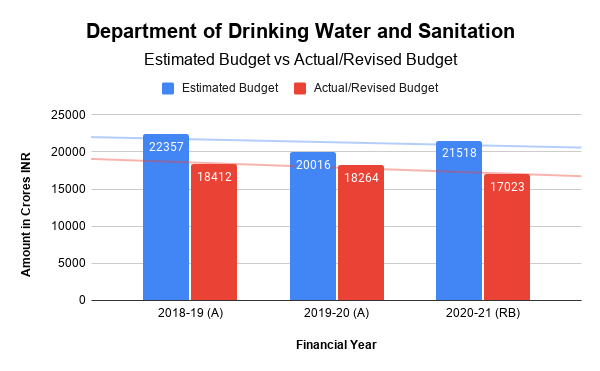
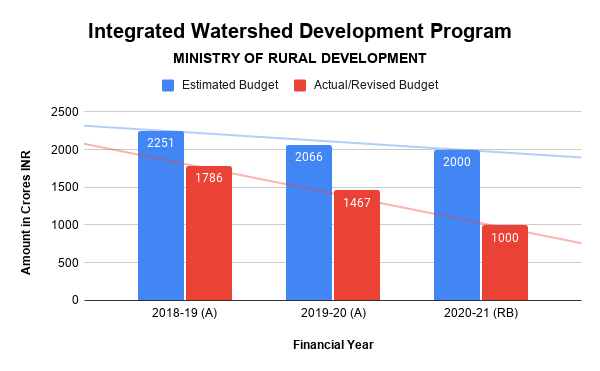
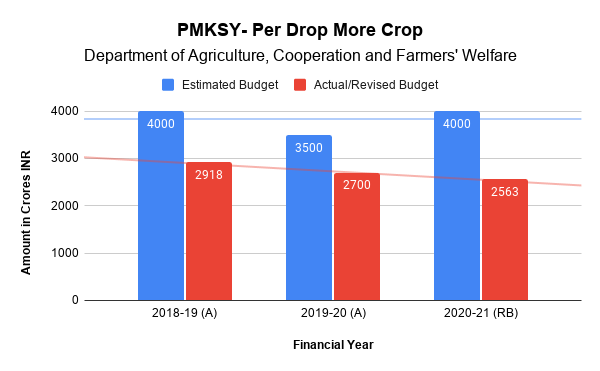
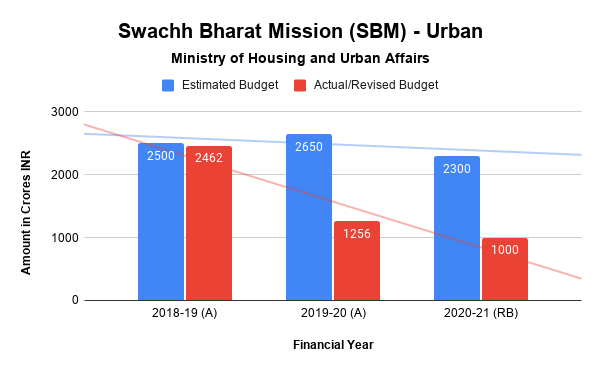
WATER FOR AGRICULTURE
Over the years, the need to prioritise water for agriculture is being neglected in the union budget. The NDA government came to power in 2014 and initiated the Pradhan Mantri Krishi Sinchai Yojana (PMKSY) by integrating all water resources development and irrigation programs. For the initial few years, a good amount of money was pumped in creating and enhancing irrigation potential in the country. Alongside that, financial provisions were also made for micro-irrigation and watershed development.
Under this, the watershed domain was side-lined substantially, but in NDA’s second term all aspects of irrigation have lagged. One, almost 1/4th of the allocation to PMKSY is going for repaying the loans. Second, important aspects like micro-irrigation and watershed are not getting financial allocation. Yet, agriculture shouldered the economy of India during the pandemic, when most other sectors rushed for government support for bailouts.
The agriculture sector needs water, which in turn needs financial resources for planning and management. However, the policymakers seem to turn a blind eye to this. Irrigation is a state subject and considerable allocation comes from the state budget but still, the union budget sets the path and approach for work.
Also, more than 50% of India’s net sown area is rainfed. Rainfed agriculture demands protective irrigation for survival and needs provisioning, but this has been neglected year after year. More than half of the cultivated lands and thereby farmers were neglected in the union budget which made inadequate allocation for irrigation in the rainfed region.
The budget allocation continues to be top-down despite the prime minister’s radio talk ‘Mann ki Baat’ and/or other public addresses repetitively urging communities to participate in water conservation. The Ministry of Jal Shakti continues to be largely focused on water resources development rather than water resources governance or management.
India’s water resources are getting degraded progressively, be it rivers, streams, lakes, ponds, springs or aquifers but the budget’s focus continues to be source management while neglecting the resource. This budget is similar in terms of provisions or priorities to previous budgets with a few exceptions. It is quite likely that after spending almost 80,000 crores in the water sector in the months to come, the country may still be faced with an acute water crisis.
Partik Kumar is currently working with Revitalising Rainfed Agriculture Network. He did his Master’s in Water Policy and Governance from TISS, Mumbai. Pkunj5512@gmail.com; +91 9967563707.
References and Endnotes
[i] All the mentioned allocations are as per the Union Budget 2021-22.
[ii] The stated total is the sum of all allocations of Ministry of Jal Shakti; Pradhan Mantri Krishi Sinchai Yojana (PMKSY) - Per Drop More Crop component of Department of Agriculture, Cooperation and Farmers' Welfare; Integrated Watershed Development Program component of Department of Land Resources; Swachh Bharat Mission (SBM) - Urban component of Ministry of Housing and Urban Affairs.
[iii] For the financial year of 2018-19 and 2019-20, the figures are of actual budget and for 2020-21, the figures are of the revised budget.














